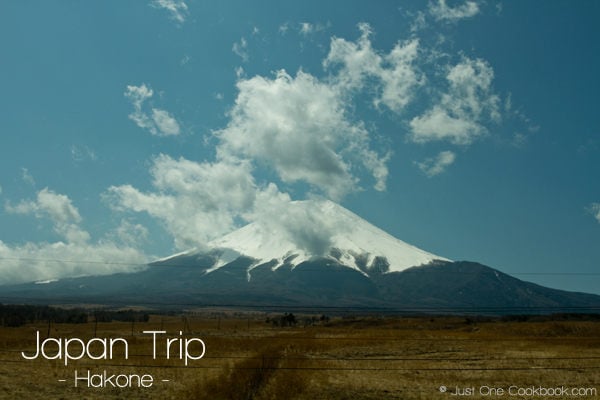 Welcome back to my Japan Trip 2012 series. If you missed my previous posts, here’s vol. 1 and vol. 2 (Kobe & Osaka). Today we’re going to Hakone (箱根)!
Welcome back to my Japan Trip 2012 series. If you missed my previous posts, here’s vol. 1 and vol. 2 (Kobe & Osaka). Today we’re going to Hakone (箱根)!
Hakone (箱根) is a town of 13,000 people and is part of the Fuji-Hakone-Izu National Park. It’s located in the mountainous far west of Kanagawa Prefecture, about 60 miles (100 km) from Tokyo. It’s a famous onsen (hot spring) resorts destination for both Japanese and international visitors because it’s relatively close to Tokyo.
If you are staying in downtown Tokyo, you can get to the Hakone area from either Tokyo or Shinjuku Station, taking the express train Romancecar and it only takes about 90 minutes.
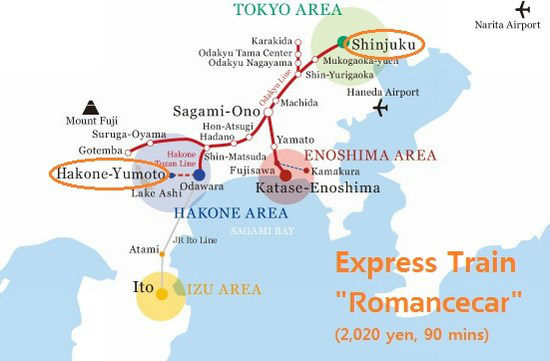
For us, my dad drove us there as we wanted to stop by the amusement park, Fuji-Q High Land (富士急ハイランド) before reaching to Hakone. From the parking lot of the theme park, we could see the beautiful Mount Fuji.
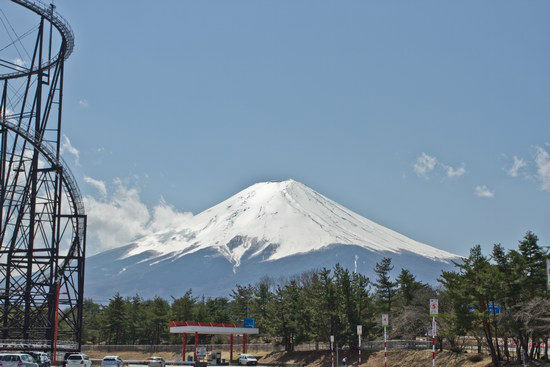
We were lucky to catch a cloudless Mt. Fuji when we first arrived because by the time we left it was already covered by clouds. In Japan, Mt. Fuji is very well known to be the mountain “hidden” in clouds. If you visit Japan and get to see Mt. Fuji on a clear day, consider yourself pretty lucky.
My children did not meet most of the height requirements in Fuji-Q High Land for the thrill rides. So we again ended up in Thomas Land inside the theme park (last visit was 3.5 years ago).
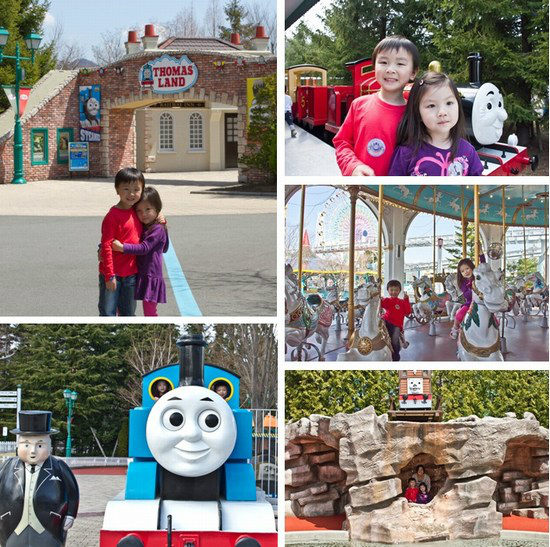
After we spent 3-4 hours in the park, it was time to go to Hakone. We booked this ryokan (Japanese styled inn) called Hakone Kowakudashi Onsen Mizunoto (箱根小涌谷温泉 水の音) about one week before the trip based on reviews from a Japanese travel site.
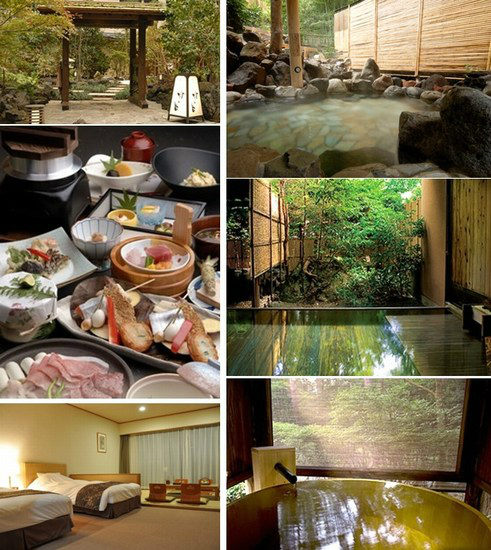 (Image: Hakone Kowakudashi Onsen Mizunoto)
(Image: Hakone Kowakudashi Onsen Mizunoto)
Internationally, hotels are mainly for travelers to sleep at night. It’s a bit different for Japanese ryokans (Japanese inns); after we check in, we spend most of the day inside of the ryokan. A person can enjoy different onsen (hot spring) baths throughout a day, relax at the lounge, take advantage of services such as massages and spa, and walk around the gardens in the premises. Typically there are also souvenir shops that carry local crafts and food inside the ryokan. My favorite part besides the onsen is the food. Typically ryokans serve extremely delicious kaiseki dinners (a traditional multi-course Japanese dinner) and breakfast. Meals are usually included for the accommodation fee and the cost is calculated by per person rather than by per room.
The room at this ryokan was decent, I would say. It’s not the super fancy kind of ryokan, but it’s clean and spacious for my children to run around. Although there are just 2 full-size beds in the room, a family of 4 can comfortably stay in this room as children can sleep on futon (traditional Japanese style beds) in Japanese tatami room. Ryokans typically start at $150 USD a person for the standard rooms all way to $500 a person for the more exclusive ones on the weekends.
There are total of 7 onsen baths, including both outdoors and indoors, at this ryokan. Each bath has several kinds of tubs with different shapes and materials. Some made of natural rocks, some made of hinoki (Japanese cypress).
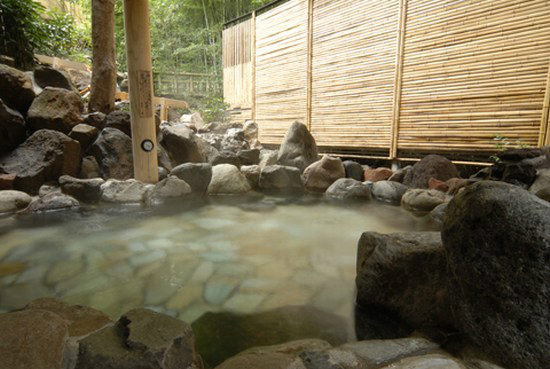
This ryokan also has some rooms with a private onsen bathtub in the balcony. That’s nice for those who are not comfortable taking baths with strangers. This ryokan also has 3 separate private baths outside in the garden (on premise) available for the hotel guests (below is one of private baths).
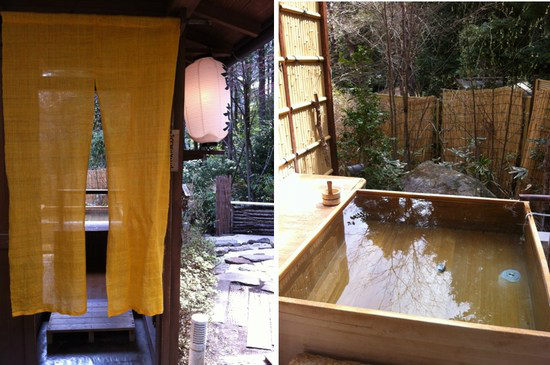
By the way, you might ask, what’s an onsen? Onsen is a term for hot springs in Japanese and this term is also used to describe the bathing facilities and inns that serve hot spring baths. As a volcanically active country, Japan has thousands of onsen throughout the country.
Onsen water is believed to have various medical effects derived from its mineral contents. A particular onsen may feature several different baths, each with water with a different mineral composition for different benefits. The Japanese believe that a good soak in onsen heals aches and pains and promotes beautiful skin.
Many onsen ryokans have alternating male-only and female-only hours, so be sure to visit each bath before the daily switch, usually at/after midnight. That way you can enjoy various kinds of baths during one stay.
If you are curious about how to take a Japanese bath, click here. After you take a bath, you wear yukata (summer kimono) and relax until dinner.
Now that we are relaxed and feel refreshed, it’s time for dinner. Dinner is usually served in your room or main dining area. Traditionally, meals are served in your room. Due to the slow economy, more ryokans are saving costs and prefer to serve in a main dining area since it requires less staff. If your ryokan allows you to dine at the tatami area of your room, a designated staff comes to serve a kaiseki style meal a course at a time. Here at this hotel, we had to go to a main dining room.
The following meals are for one person. We started off from…
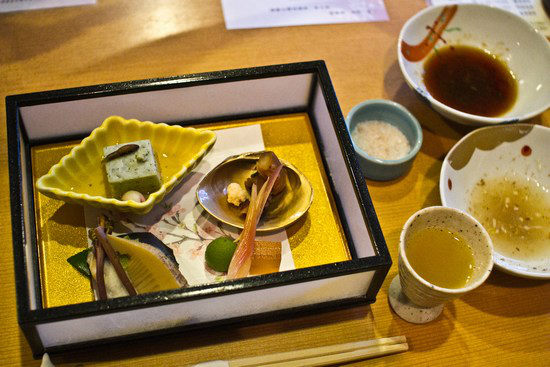
Appetizer | Zensai (前菜)
Lotus Tofu (蓮豆腐), Grilled Bamboo Shoot (焼き筍), Grilled sawara/Japanese spanish mackerel (鰆木の芽焼), Simmered octopus (蛸柔らか煮), Simmered red snapper (鯛の子旨煮), Vinegared myoga/Japanese ginger (酢取り茗荷子), Noshi Ume (のし梅), Wakamomo (若桃)
*****
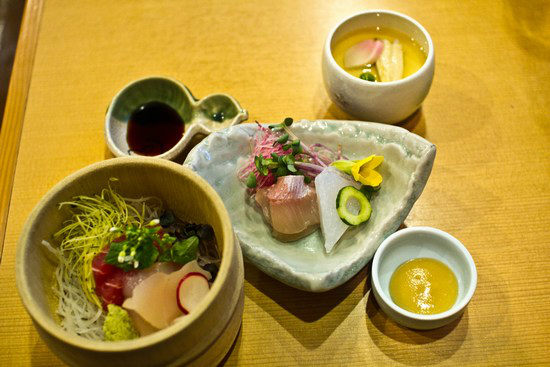
Warm Vegetable Dish | Onsai (温菜) (top right)
White fish wrapped with Yuba (tofu skin) (白魚東寺巻き)
Sashimi | Otsukuri (お造り)
Tuna Sashimi (鮪引き造り), Alfonsino Sashimi (目鯛平造り), Fuji-Iwana Sashimi (富士岩魚重ね造り), Handmade Konjac (手延ばし蒟蒻)
*****
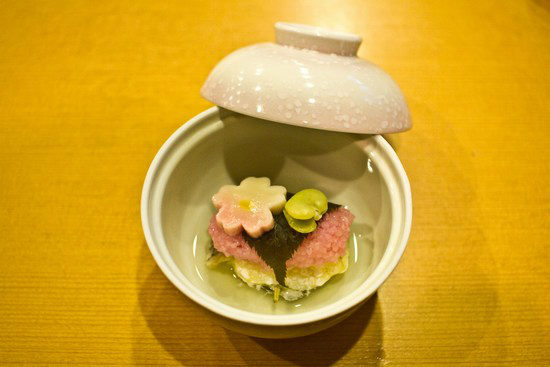
Simmered Dish | Nimono (煮物)
Steamed spring snapper wrapped with sakura leaf (春鯛桜蒸し)
*****
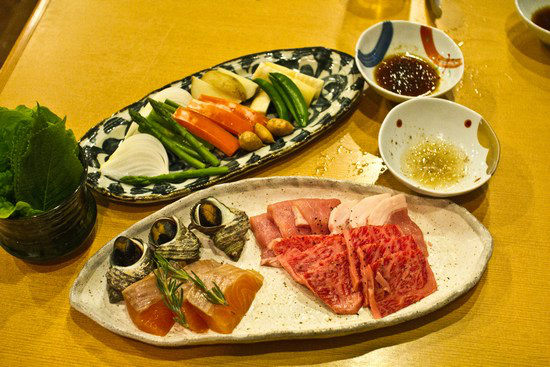
Grill | Aburi Yaki (炙り焼)
Wagyu Calbi (和牛カルビ), Hakone piedmont pork rib eye (箱根山麓豚ロース), Masu salmon (桜鱒), Turban shell (サザエ壺焼き), Assorted vegetables (旬野菜のいろいろ)
For the main course, we were able to cook the ingredients on the grill built in our table. You can eat right after they are cooked.
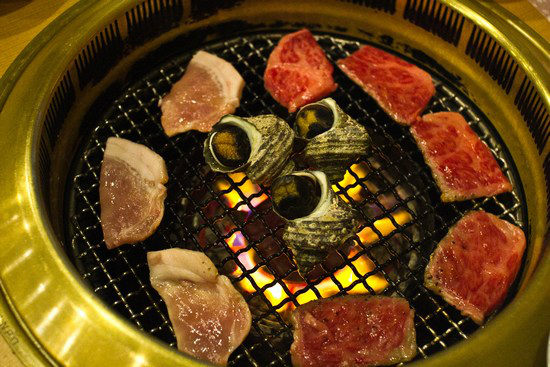
*****
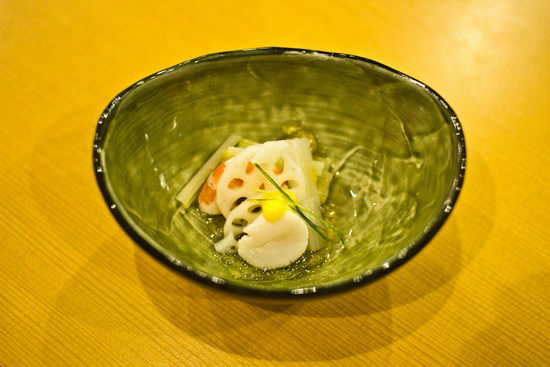
Vinegared Dish | Tomezakana (止め肴)
Scallope (貝柱), Prawn (海老), Udo (独活(うど)), Lotus root (蓮根) in vinaigrette sauce
*****
Traditionally kaiseki meal ends with rice and miso soup. Since the start of the meal, Kamameshi has been cooking in an individual size iron pot and was just about ready when we finished most of the food.
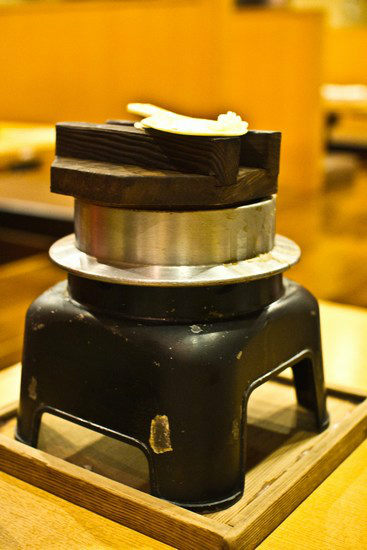
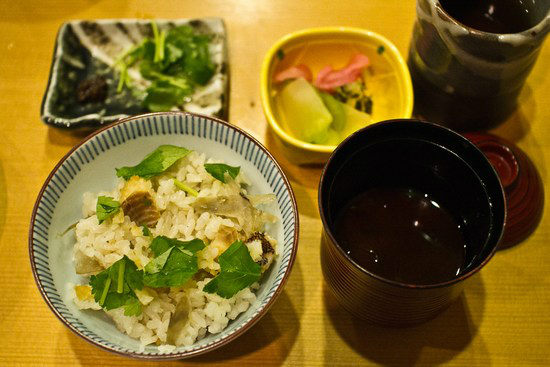
Rice | Oshokuji (お食事)
Ainame & burdock root kamameshi (油目(あいなめ)と牛蒡の釜飯), Pickles (香の物)
Soup | Tomewan (留椀・味噌汁)
Akadashi Miso Soup (赤だし)
* Remember, the Japanese has the miso soup when rice is served.
*****
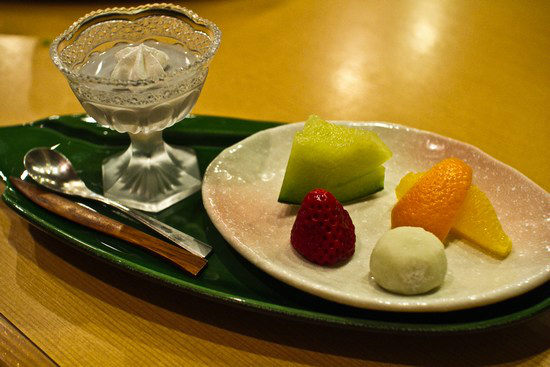
Dessert
Black sesame mousse, fruits, and mochi (本日のデザート)
The food was more than enough. We really have to try hard to finish everything on the table. Typically the meals served at ryokans are really delicious, comparable to high end restaurants in the US. The kaiseki meals use seasonal and local ingredients and the chef and the ryokan really take pride in the quality of food they provide. The food always tastes very fresh and the colors are mesmerizing. The chef’s job is not only to make sure the food tastes good, but looks good as well. If you are serious about the quality of food at ryokans as your decision factor for staying, Japanese travel sites offer reviews on ryokans and the rating of their food.
After we took a rest from our full meal, we went to take a bath again. Yep, that’s what you do when you visit an onsen ryokan. Your body become nice and warm after the bath and you have a good night sleep!
Next morning after we woke up, you know what we did… go take a bath again! By this time our skins are so nice and smooth… my children love taking Japanese baths. They even requested us to remodel our American home bath tub to Japanese style deep tub. I also hope we can change it one day!
By the time we were done with a quick morning bath, we were hungry and ready for breakfast!
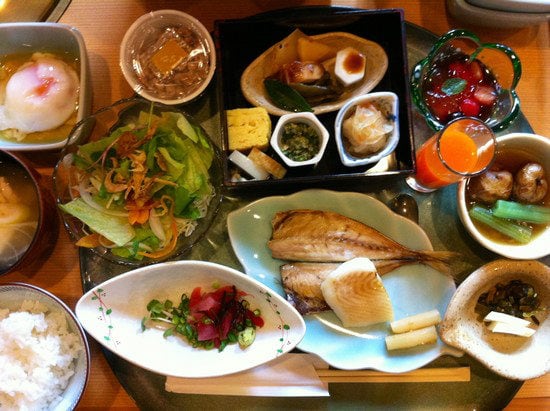
Japanese Style Breakfast
(from top left) Onsen tamago, natto (do you like it?), simmered bamboo & taro, strawberry Jelly, miso soup, salad, tamagoyaki, kamaboko (fish cake), spinach gomaae, (forgot what this was), vegetable juice, rice, tuna sashimi, grilled horse mackerel (aji), simmered fuki (Japanese butterbur sprout) & potato, pickles.
As I was enjoying the gorgeous food and looking out the window at the beautiful scenery, it made me a bit homesick and realized that there are parts of Japan I deeply miss. Great food of course, the joy and beauty of having seasons (I live in California…), history and culture Japan offers… I left Japan when I was 20 years old and I really wish I had traveled more to see my country. Anyway…
After we checked out from the ryokan, we decided to go to volcanically active Ōwakudani geysers. First we went to Gora (強羅) Station to take Hakone Tozan Cable Car to Sounzan (早雲山) Station.
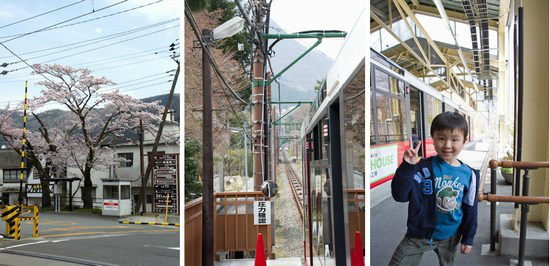
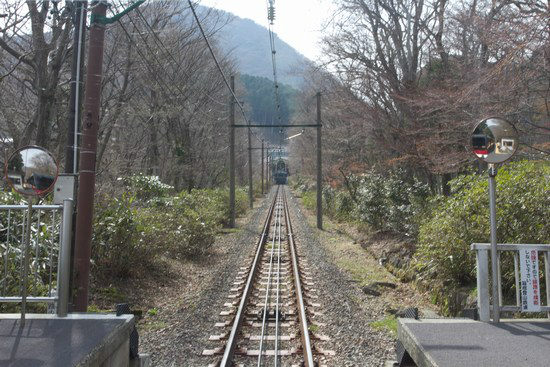
Then from Sounzan Station, we took Hakone Ropeway to Ōwakudani (大涌谷) Station.
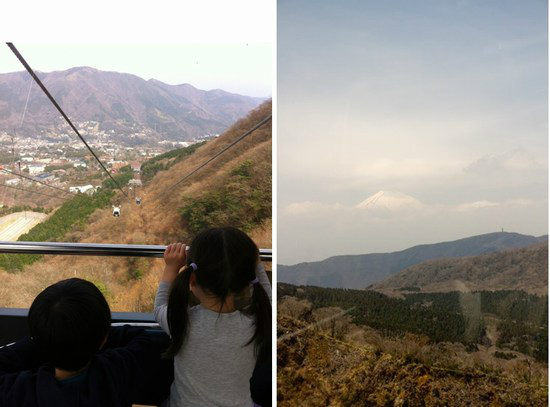
On the way, we could see Mount Fuji on the right hand side. Again, most of the mountain was covered by clouds.
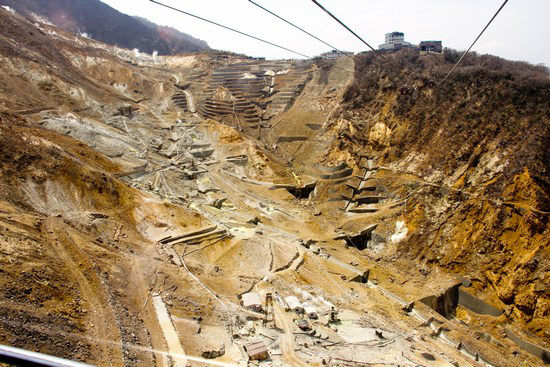
These are the pipes that carry hot spring water to hotels and ryokans in the area. We see Ōwakudani Station in front of us.
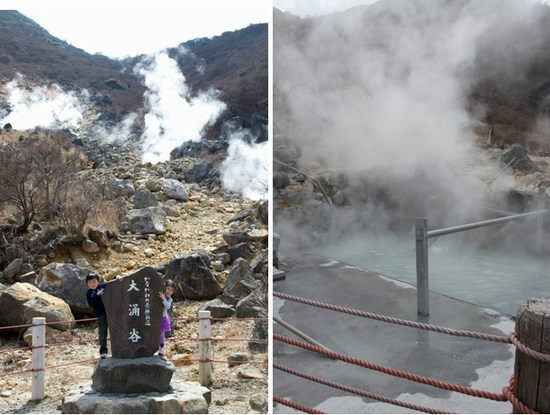
Here we are at Ōwakudani (大涌谷 “Great Boiling Valley”). It is a volcanic valley with active sulfur vents (left) and hot springs (right).
A lot of domestic and international tourists come here to watch volcanic activity and eat Black Egg (黒卵). We were able to see the worker trying to put fresh eggs in the hot spring water.
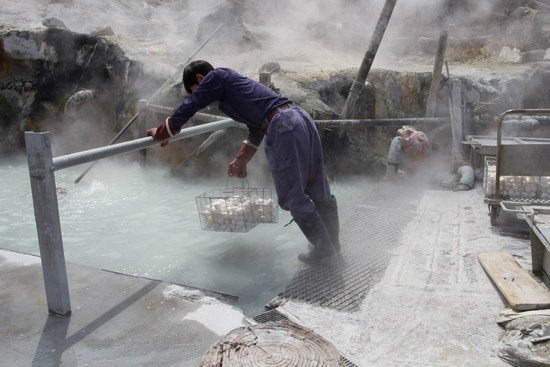
These eggs are hard-boiled in the hot springs. The boiled eggs turn black and smell slightly sulfuric. Consuming the eggs is said to increase longevity; eating one is said to add seven years to your life.
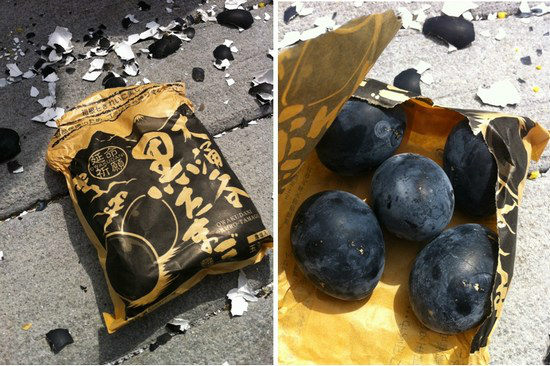
Look, my daughter was pinching her nose while I was taking a picture of these eggs for my facebook page…
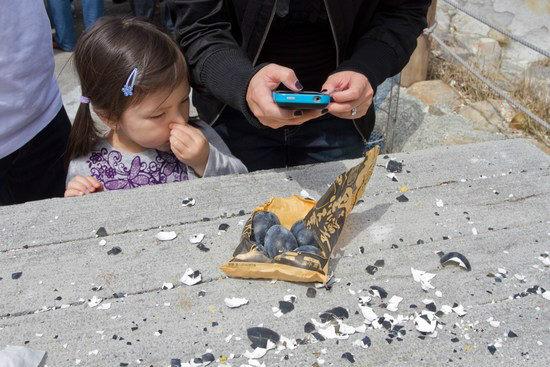
Yeah, it’s pretty smelly around here because of the strong sulfur odor. Oh by the way, onsen water at ryokans doesn’t have any smell because it’s already treated. So don’t worry, you can take a bath without pinching your nose!
Thank you for reading this long post today. The next Thursday will be my final Japan Trip post. I hope you will come back to check it out!
Continue reading Vol. 4 of Japan Trip 2012.
*****
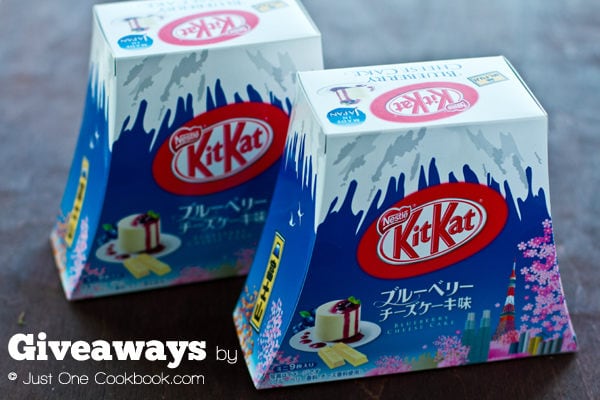
We had a lot of luggage for this trip and I could only bring back something small and light as souvenirs this time. If you have been to Japan, you probably know that each region likes to come up with unique flavor snacks featuring their famous produce (sometimes not related at all). I got these blueberry cheesecake Kit Kats at Narita Airport on my way home and I’d like to give these as giveaways. I thought about getting wasabi flavor Kit Kats for fun instead, but my husband convinced me not to (Remember? We both don’t like wasabi…). I thought it’s cute that these Kit Kat Boxes are the shape of Mount Fuji.
By the way, did you know Kit Kat has over 100 flavors in Japan? Check out this link for all the flavors invented in Japan. Isn’t it crazy?
So here we go. Enter to win one of two (2) boxes of Kit Kat!
- This giveaway is WORLDWIDE!
- The giveaway expires on May 23th 2012, Wednesday, 12:00pm PST.
- Entries that do not meet the entry requirement will not be considered.
- The winners will be randomly chosen using random.org and announced in the post on Monday 24st.
- Full disclosure: This giveaway is sponsored by yours truly.
Required Entry: please leave a comment on this post.
Extra Entries:
- Subscribe Just One Cookbook by Email, then leave a separate comment (even you are already subscribing).
- Like Just One Cookbook on Facebook, then leave a separate comment (even you already follow the fan page).
Good luck!
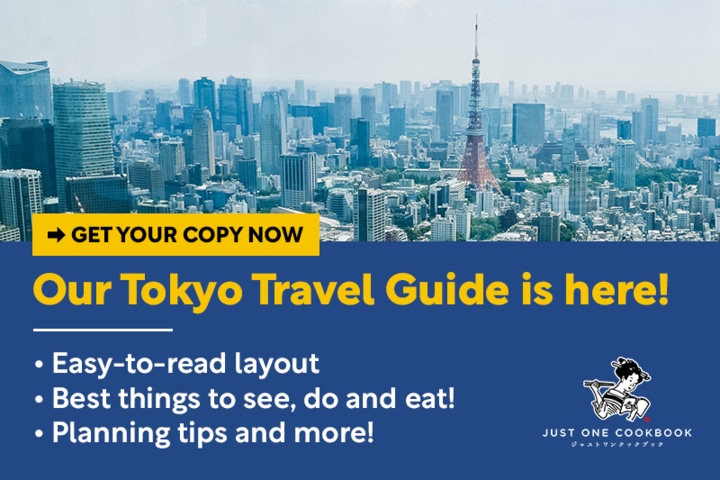










Hi Nami,
We will go to Hakone in July 25, 2019, we really cannot wait to go there. This will be our first time going to Japan 🙂
I’ve got few questions regarding the Hakone free pass and express romance car if you know about it. We will be leaving with my parents and my 3yo son. For Adults, we will use Hakone free pass shinjuku return (as regular ticket) + purchase the romance car online.
However, it seems for my son, I also need to purchase the romance car as well, is it true? I can purchase it online but what how can I buy the child regular ticket as we will depart from shinjuku at 7am? and do we need to purchase the hakone free pass for him? Please help if you know about it. I have totally no idea how it works in Japan 🙁
It’s really sad the Owukudani ropeway is currently being suspended due to the Volcano alert.
Hi Yori,
If you want a seat for your son on the romance car, then you can buy a children’s ticket. If you plan to hold your son on your lap then a ticket is not necessary. He also doesn’t need a Hakone Freepass. Many locations/services in Japan do not charge children under 6 years old.
Cheers